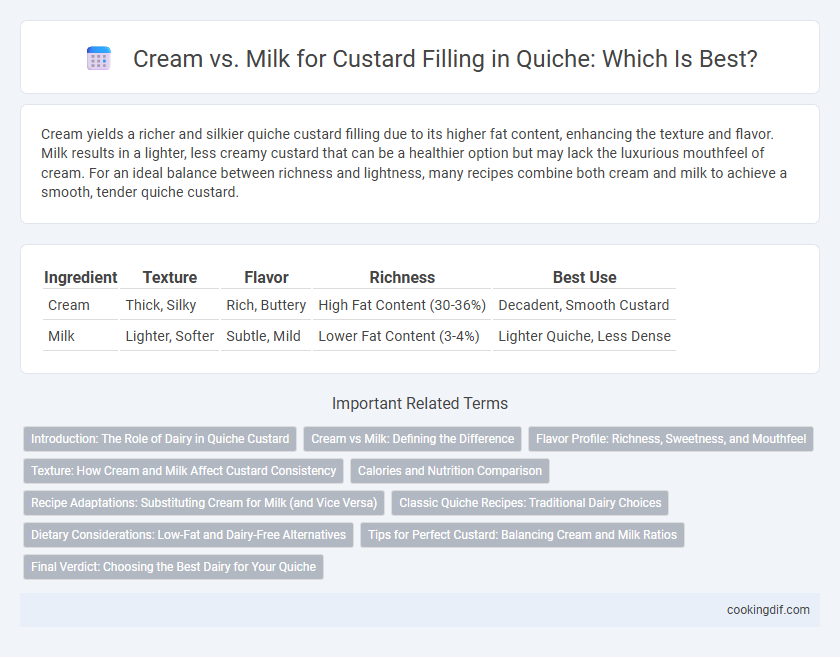Cream yields a richer and silkier quiche custard filling due to its higher fat content, enhancing the texture and flavor. Milk results in a lighter, less creamy custard that can be a healthier option but may lack the luxurious mouthfeel of cream. For an ideal balance between richness and lightness, many recipes combine both cream and milk to achieve a smooth, tender quiche custard.
Table of Comparison
| Ingredient | Texture | Flavor | Richness | Best Use |
|---|---|---|---|---|
| Cream | Thick, Silky | Rich, Buttery | High Fat Content (30-36%) | Decadent, Smooth Custard |
| Milk | Lighter, Softer | Subtle, Mild | Lower Fat Content (3-4%) | Lighter Quiche, Less Dense |
Introduction: The Role of Dairy in Quiche Custard
Cream and milk serve distinct roles in quiche custard, impacting texture and richness. Heavy cream creates a velvety, dense filling with a higher fat content, while milk offers a lighter, more delicate custard. Choosing between cream and milk directly influences the custard's mouthfeel and flavor balance in a quiche.
Cream vs Milk: Defining the Difference
In quiche custard fillings, cream offers a higher fat content, typically around 36-40%, which results in a richer, silkier texture and more luxurious mouthfeel compared to milk's lower fat range of 1-3%. Milk's thinner consistency yields a lighter custard that is less dense and more delicate, suitable for those preferring a less rich quiche. The choice between cream and milk significantly impacts the quiche's overall flavor profile, texture, and moisture, making cream ideal for decadent fillings and milk better for lighter, more nutritious options.
Flavor Profile: Richness, Sweetness, and Mouthfeel
Cream in quiche custard filling imparts a richer, more velvety mouthfeel with pronounced sweetness, enhancing the overall indulgence of the dish. Milk produces a lighter texture with subtle sweetness, allowing other ingredients like cheese and vegetables to shine without overwhelming richness. Choosing cream intensifies the flavor profile, while milk offers balance and a delicate custard consistency.
Texture: How Cream and Milk Affect Custard Consistency
Cream creates a richer and silkier custard filling for quiche due to its higher fat content, yielding a smooth and velvety texture. Milk, with lower fat, produces a lighter and more delicate custard that is firmer and less rich. Balancing cream and milk in the custard mixture can achieve an ideal consistency that enhances both creaminess and structural stability.
Calories and Nutrition Comparison
Using cream in quiche custard filling increases calorie content significantly, with heavy cream averaging around 52 calories per tablespoon compared to whole milk's 9 calories. Cream offers higher fat content, contributing to a richer texture and more saturated fats, while milk provides fewer fats and more protein per serving. Choosing milk can reduce overall calories and fat, making the quiche lighter but less creamy compared to cream-based custards.
Recipe Adaptations: Substituting Cream for Milk (and Vice Versa)
Substituting cream for milk in quiche custard filling results in a richer, creamier texture with enhanced flavor and a higher fat content, ideal for indulgent recipes. Using milk instead of cream lightens the custard, producing a less dense quiche with a slightly firmer set and fewer calories. Adjustments in baking time and egg-to-dairy ratio may be necessary to maintain the custard's ideal consistency when altering between cream and milk.
Classic Quiche Recipes: Traditional Dairy Choices
Classic quiche recipes typically favor heavy cream over milk for custard filling due to its rich texture and ability to create a smooth, velvety consistency. Heavy cream's higher fat content enhances the flavor, providing a luxurious mouthfeel that milk cannot match. Using cream ensures a more stable custard that holds its shape well during baking, resulting in a traditional quiche with a tender, custardy bite.
Dietary Considerations: Low-Fat and Dairy-Free Alternatives
Using low-fat milk instead of heavy cream in quiche custard reduces calories and saturated fat, making it suitable for low-fat diets without compromising texture. Dairy-free alternatives like almond milk or coconut milk cater to lactose intolerance and vegan diets, though they may slightly alter the custard's richness and flavor profile. For optimal consistency, blending these alternatives with silken tofu or cashews can enhance creaminess while maintaining a dairy-free and low-fat custard filling.
Tips for Perfect Custard: Balancing Cream and Milk Ratios
Use a ratio of two-thirds heavy cream to one-third whole milk for a rich and smooth quiche custard that sets perfectly without being too dense. Incorporating only cream results in a firmer texture, while relying solely on milk yields a lighter, less creamy filling. Adjusting the fat content in this balance enhances the quiche's silkiness and flavor depth, ensuring a custard that holds its shape without curdling.
Final Verdict: Choosing the Best Dairy for Your Quiche
Heavy cream creates a richer and silkier custard filling due to its higher fat content, enhancing the quiche's texture and flavor. Milk offers a lighter, less dense custard, resulting in a more delicate and less creamy quiche. For a perfectly balanced quiche, combining half-and-half or mixing cream with milk allows control over richness while maintaining a smooth custard consistency.
cream vs milk for custard filling Infographic

 cookingdif.com
cookingdif.com